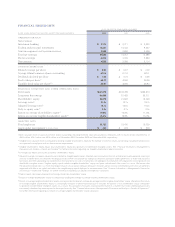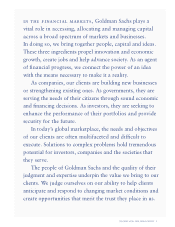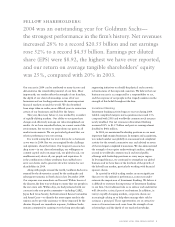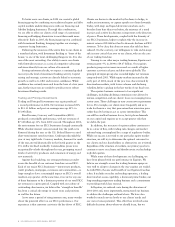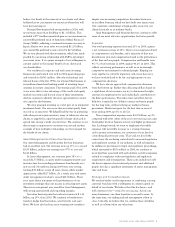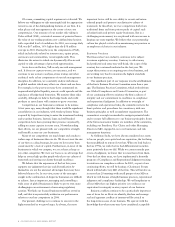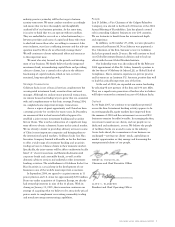Goldman Sachs 2004 Annual Report Download - page 6
Download and view the complete annual report
Please find page 6 of the 2004 Goldman Sachs annual report below. You can navigate through the pages in the report by either clicking on the pages listed below, or by using the keyword search tool below to find specific information within the annual report. To better serve our clients, in 2004 we created a global
financing group by combining our traditional equity and debt
capital markets underwriting areas with our financing and
liability hedging businesses. Through this combination,
we are able to offer our clients a full range of customized
financing and hedging alternatives to meet their needs more
effectively. Early in 2005, the financing group was combined
with Investment Banking, bringing together our strategic,
corporate-facing businesses.
Delivering the resources of the entire firm to our clients in
a seamless fashion, with Investment Banking as “front of the
house,” is one of the most challenging things we do. It is also
one of the most rewarding. Our ability to serve our clients
with firmwide resources is a critical competitive advantage
and stems directly from our culture of teamwork.
Barring unforeseen shocks, we expect a continued gradual
recovery in the level of investment banking activity. Capital
raising and strategic activity are directly linked to economic
growth as well as to CEO and investor confidence. While
confidence has certainly increased from the lows of a few years
ago, further increases are needed to produce more robust
Investment Banking results.
TradingandPrincipalInvestments
Trading and Principal Investments once again produced
a record performance in 2004. Net revenues increased 28%
to $13.33 billion and pre-tax earnings were up 44% to
$5.04 billion.
Fixed Income, Currency and Commodities (FICC)
produced a remarkable performance, with net revenues of
$7.32 billion up 31% from 2003’s record. Throughout 2004,
the environment for our FICC businesses changed continually.
While absolute interest rates remained low, the yield curve
flattened during the year as the U.S. Federal Reserve raised
short-term interest rates four times. Credit spreads ended the
year at very tight levels. Currency markets, dormant for much
of the year, moved dramatically in the fourth quarter as the
U.S. dollar declined markedly. Commodities prices were
exceptionally volatile throughout the year, prompting record
levels of activity by producers and consumers of energy and
raw materials.
Against this backdrop, our strong performance under-
scores the breadth of our customer franchise across FICC.
Each of our major FICC businesses — interest rate products,
credit products, mortgages, currencies and commodities — is
large enough to have a meaningful impact on FICC’s overall
results in any quarter. At the same time, it is rare for any one
of these businesses to be a dominant portion of our total FICC
net revenues in a given period. Coupled with our culture of
outstanding client service, we believe this “strength in breadth”
has been a critical advantage in recent years and positions
us well for the future.
As we enter a period of rising interest rates, many wonder
about the potential effect on our FICC performance. Our
experience is that customer activity is the key driver of FICC.
Clients are drawn to the market by the desire to hedge, to
reallocate investments, to capture upside or to limit downside.
Today, with deep and liquid derivatives markets and a
broader client base than ever before, the existence of a trend
in prices and activity has become as important as the direction
of prices. These developments, coupled with the diversity of
our FICC businesses, helps to explain why the increase in
interest rates in 2004 did not lead to dramatic declines in FICC
revenues. To be clear, this does not mean that risk has been
reduced. On the contrary, our willingness to take and manage
risk is more critical than ever to our clients, who are the core
of our trading franchise.
Turning to our other major trading business, Equities net
revenues grew 9% in 2004 to $4.67 billion. Our equities
products group net revenues increased as a result of higher
customer activity in shares and derivatives globally. The
principal strategies group also recorded higher net revenues
compared with 2003. While equity markets increased in the
early part of 2004, much of the year was characterized by
directionless markets, with lower volumes and declining
volatility, before a pickup in the last weeks of our fiscal year.
The equities business continues to face significant
challenges, including declining commission rates driven by
intense competition and our clients’ focus on managing trans-
action costs. These challenges in turn create new requirements
for us. For example, our clients more frequently ask us to
trade for them in a way that guarantees their execution price
rather than by having us act as a pure intermediary. This
can still be excellent business for us, but it places demands
on our capital and requires us to accept greater risk than
we did in the past.
In addition, the structure of equity markets continues to
be in a state of flux, with trading rule changes and market
reforms being contemplated by a range of regulatory bodies.
While our success is not tied to any particular equity market
structure, we will try to determine the optimal outcome for
our clients and our shareholders as alternatives are reviewed.
Regardless of the structure of markets, our primary goal is to
continue to serve our clients and thereby retain our leadership
in global equities.
While some of these developments are challenging, we
have been pleased with our performance in Equities. We
believe our strength across the trading business equips us
very well to adapt to changes in the way equities are traded.
As with FICC, the size and breadth of our Equities franchise
is key. It includes our sales and trading operation, a leading
direct market access capability, a dominant prime broker, our
long-standing proprietary trading business and a commitment
to providing world class research.
In Equities, we reduced costs during the downturn of
2001-2003 and, more importantly, restructured our business
to address the challenges outlined above. We have also
worked to match service levels to our clients’ needs and
our own revenue potential. This effort has involved some
difficult decisions about where we should focus, but we
4GOLDMAN S A C H S 2 0 0 4ANNU A L R E P O RT
4GOLDMAN S A C H S 2 0 0 4ANNU A L R E P O RT


